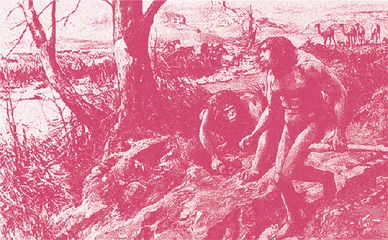The Most Embarrassing Archaeological Blunders令人啼笑皆非的考古乌龙
作者: 拉杜·亚历山大 刘希译

The Persian Princess
波斯公主
In 2000, Pakistani authorities came into possession of a unique artifact that had been put on sale on the black market—a Persian mummy. Just days after its recovery, Pakistani archaeologists held a press conference where they presented the thrilling find, claiming it was an Egyptian-style female mummy dated to approximately 600 BC, placed in a wooden coffin with cuneiform writing and images of the Zoroastrian deity Ahura Mazda. To add to the excitement, there was speculation that the mummy was a daughter of King Xerxes I.
2000年,巴基斯坦当局获得了一件非比寻常的文物——一具曾在黑市买卖的波斯木乃伊。木乃伊收归几天后,巴基斯坦的考古学家召开了记者招待会,在会上公布了这一重磅发现,宣称这具埃及风格的女性木乃伊大约可以追溯到公元前600年,安置木乃伊的木制棺材上刻有楔形文字和索罗亚斯德宗教的神——阿胡拉·马兹达的形象。更令人激动的是,有猜测称这具木乃伊是波斯国王薛西斯一世之女。
The value and magnitude of the discovery was so grand that it immediately started an international argument between Pakistan, Iran, and Afghanistan over who was the rightful owner of the mummy. But then enough time passed that some actual examinations could be done to verify its authenticity.
无论在考古价值还是影响力上,该发现都意义非凡,于是,关于这具木乃伊的法定归属权问题,巴基斯坦、伊朗和阿富汗之间很快便展开了国际论战。然而过了很长时间,人们才做了一些实际检测来辨别真假。
First, tests revealed that the wood from the coffin was only 250 years old so, just like that, the “Persian princess” was revealed to be a fake. But, in a disturbing twist, the mummy itself turned out to be much younger than that. In fact, it belonged to a woman in her early 20s who had been killed just a few years prior. Therefore, the recovery of an ancient mummified princess turned into the investigation of a modern murder victim.
首先,检测发现,棺材的木龄仅仅250年,“波斯公主”之说自然也是无稽之谈。然而,更让人不安的反转是,这具木乃伊比棺材的木龄要小很多。事实上,她是几年前才遇害的一名女性,死时刚过20岁。这样一来,重现古代木乃伊公主就演变成调查现代谋杀案的被害人。
Piltdown Man
皮尔丹人
At the start of the 20th century, anthropologists and archaeologists were eagerly searching for a “missing link,” a previously-undiscovered species that would bridge the gap between ape and man. Understandably, the scientific world became extremely excited in 1912 when British amateur archaeologist Charles Dawson claimed to have found this link—skull fragments of an early human dubbed1 Piltdown Man.
20世纪之初,人类学家和考古学家都在积极寻找“丢失的一环”——一个先前从未被发现的、连接猿和人的物种。不难想象,当1912年英国业余考古学家查尔斯·道森声称发现了这“丢失的一环”时,整个科学界是何等欣喜若狂。道森发现的是一个远古人的颅骨碎片,这个远古人被命名为“皮尔丹人”。
Dawson enlisted the help of a preeminent paleontologist named Arthur Smith Woodward who helped reconstruct the skull. They then presented their findings to their peers at the Geological Society of London, proclaiming that the fossils belonged to a human ancestor from 500,000 years ago which they named Eoanthropus dawsoni or “Dawson’s dawn-man.”
道森争取到亚瑟·史密斯·伍德沃德的帮助,这位杰出的古生物学家帮助他修复了颅骨碎片。不久之后的伦敦地质学会上,他们向同仁们展示了自己的发现,称这个颅骨化石属于50万年前的人类祖先——他们将其命名为“道森的黎明人”。
Over the following decades, Piltdown Man lost some of its luster because scientists kept discovering fossils from other ancient humans. However, it wasn’t until 40 years later in 1953 that Piltdown Man was actually proven to be a fake, made by carefully combining bones from humans and apes. It was a severe black eye for the scientific world and still serves as a warning about the fallibility of archaeology even now, a hundred years later.
其后几十年,随着科学家不断发现其他古人类的化石,皮尔丹人的光环有所暗淡。然而,直到40年后的1953年,皮尔丹人才被真正证实是一场骗局,那具颅骨其实是由类人猿和人类的颅骨精心拼凑而成的。这对当时的科学界来说是一个莫大的耻辱,时至百年后的今天,这一事件仍是对考古学存在谬误的一种警示。
As to the culprit2 behind the hoax3, their identity still remains a mystery, although recent research into the topic suggests that it was Charles Dawson himself who orchestrated4 the deception.
至于这场骗局的罪魁祸首,其身份仍是一个谜,不过近期的一些调查表明,是查尔斯·道森本人导演了这场骗局。
The Sarcophagus of Tarragona
塔拉戈纳石棺
This semi-obscure archaeological bunkum is somewhat unique as it fooled people once, then was dismissed as a hoax and, decades later, fooled them again.
这则真假难辨的考古学传言比较独特:它曾迷惑过众人一次,后来被识破是骗局,然而几十年后再次迷惑了众人。
It started all the way back in 1850 when workers in Tarragona, Spain, uncovered a marble sarcophagus with unusual inscriptions on it that appeared to show a giant man breaking apart two boulders as many other people approached him from all directions. A local antiquarian and archaeologist named Bonaventura Hernández Sanahuja claimed it depicted the story of Hercules opening the Strait of Gibraltar.
传言可以追溯到1850年,在西班牙东北部城市塔拉戈纳,工人们挖掘出了一个大理石质地的石棺。石棺上刻有一些不同寻常的图画,显示一个巨人劈开两块巨石,许多人从四面八方向他靠拢。博纳文图拉·埃尔南德斯·萨纳乌哈是当地的一名古文物学家和考古学家,他声称石棺上的图画讲述的是大力神赫拉克勒斯劈开直布罗陀海峡的故事。
This would have been fine by itself, except that Sanahuja concluded that the procession of people on the inscription were coming from Egypt. He was of the opinion that around 3,600 years ago, the Egyptians overthrew the Hyksos people and pursued them all the way into Spain. Sanahuja believed this Egyptian tomb found in Tarragona was evidence of this. Not a lot of other scholars agreed with this notion, most of them dismissing the sarcophagus as a hoax, although whether it was perpetrated by Sanahuja himself or somebody else was never established.
这个说法本身没有问题,不过萨纳乌哈的结论有问题——他认为石棺上的人群来自埃及。他的论据是,大约3600年前,埃及人推翻了希克索斯人的政权,并把他们一路赶到西班牙。萨纳乌哈认为塔拉戈纳出土的石棺恰能证明这一史实。同意这个说法的学者不多,大多数学者认为石棺是一个骗局,但幕后黑手究竟是萨纳乌哈还是另有其人,始终没有定论。